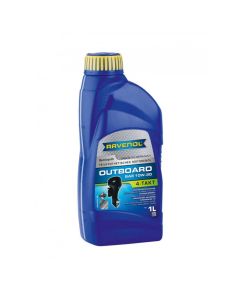Marine
-
 RAVENOL Outboardoel 4T SAE 10W-30As low as €10.49
RAVENOL Outboardoel 4T SAE 10W-30As low as €10.49- semi-synthetic engine oil with special formulation
- for 4-stroke outboard engines
- for Mecury, Yamaha, Honda, Evinrude, Tohatsu etc.
Buy outboard gear lube and engine oil online at ATO24
Motor oils for marine engines differ from oils for the automotive sector, especially in their additives. While automobile engines are every time in use, it is important that oils for marine engines have preservative properties to even during long periods of their protective effects not to lose. In addition, the boat engines differ in 2-stroke and 4-stroke engines. These ones need their own oil. In our shop you will get a wide range of 2-stroke and 4-stroke outboard oil of the brands Ravenol and Amsoil. This includes engine oil and transmission oil. These are mineral, semi-synthetic or fully synthetic. Especially the selection of Ravenol oil in our shop is great. They impress with perfect additives, tailor-made for 2-stroke and 4-stroke outboard motors. In our shop you get the outboard oil in 0,946 liters up to 20 liters.
Engine oil 10W-30: Large selection, wide range, top prices at ATO24
You are looking for a suitable 10W-30 engine oil for your vehicle? In the online store of ATO24 you are right!
We help you to find out what is important for your vehicle and to buy exactly the right one from our large selection of SAE 10W-30 engine oils. In addition to our competent advice, we offer you attractive prices.
In addition to the engine oil viscosity SAE 10W-40, oils of the viscosity class SAE 10W-30 are among the most demanded engine oils with the cold viscosity 10W. But what exactly does 10W-30 actually mean and why are there so many different oils despite the same viscosity? We will clarify these and other questions in the course of this blog article.
What does 10W-30 mean?
SAE 10W30 is what is known as a multigrade viscosity. Correctly written out as 10W-30, the two viscosity indexes given, 10W and 30, refer to all-season use (suitability for winter and summer use). These multigrade oils were developed over 50 years ago and were intended to replace the procedure of having to change oil at summer and winter time. The viscosity specification in cold (10W) and warm (30) viscosity indicates the flowability of the oil at high and low temperatures.
10W stands for the flowability in winter (this is where the W index comes from). The value 10 is not a directly measurable value of a certain unit but an index number. The lower the number before the W, the better the flowability at cold temperatures and cold starts. A 5W-30 engine oil therefore has better flow properties when cold than a 10W-30 engine oil.
The number 30 stands for the flowability of the oil at a temperature of 100 degrees. Again, the lower the number, the lower the viscosity at a temperature of 100 degrees. Accordingly, a 10w30 engine oil here is comparable to a 5W-30 engine oil.
Buy 10W-30: There is to consider!
Even if the vehicle manual recommends a 10w-30 engine oil, this does not immediately mean that you have found the right 10W30 oil. When buying a 10W-40, attention must be paid to the prescribed specification and approval. They represent the particular chemical properties of an oil.
10W-30 engine oil approvals
As always, your vehicle may require a approval in addition to the 10W-30 viscosity. These approvals are listed on the bottle label next to the specifications. The best known approvals are those of BMW (e.g. LL-04), VW (e.g. VW 507 00) and Mercedes Benz (e.g. MB 251.0). The approvals with the engine oil are comparable with a quality seal of the automobile manufacturers. Thus this manufacturer issues a certain chemical characteristic of oils, which must be fulfilled, in order to be permissible for the cars from the own product series.
What engine oil approvals occur together with viscosity SAE 10W-30? Among many others, common engine oils are of the following clearances and recommendations 10W-30 engine oils:
What is the difference between 10W-30 and 10W-40?
Both viscosities share the "10W" winter property, which means they have the same properties at low temperatures and cold starting. The indices 30 and 40 refer to a difference at high temperatures. Thus, the 10W-40 shows a slightly higher viscosity at high operating temperatures. This difference can be advantageous if the engine has oil losses with a 10W-30 motor oil.


